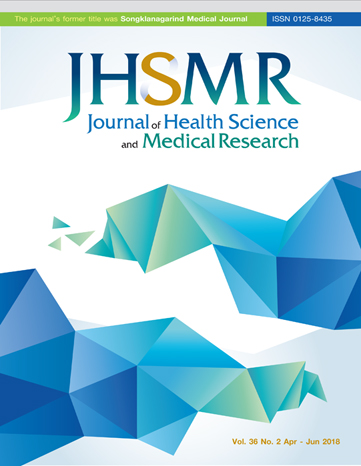Nitrofurantoin and Fosfomycin Susceptibility Among Outpatient Uropathogens in a Tertiary Care Center in Southern Thailand
DOI:
https://doi.org/10.31584/jhsmr.2018.36.2.7Keywords:
fosfomycin, nitrofurantoin, susceptibility, uropathogens, UTIsAbstract
Objective: To document susceptibility to fosfomycin and nitrofurantoin among uropathogens isolated from the Out Patient Department and Emergency Room of Songklanagarind Hospital.
Material and Methods: From October 2011 to May 2012, bacteria isolated from urine specimens of outpatients with pyuria were evaluated for susceptibility to nitrofurantoin and fosfomycin. The medical records of the patients were reviewed for uropathogens and other antimicrobial susceptibilities. The urinary tract infections (UTIs) were classified into complicated and uncomplicated. Factors associated with fosfomycin and nitrofurantoin susceptibilities were also studied.
Results: The study included 324 patients with positive urine cultures. Complicated UTIs and uncomplicated UTIs were found in 72.8% and 27.2%, respectively. The most common causative uropathogen was Escherichia coli (E. coli) (71.9%) followed by Klebsiella pneumoniae (16.7%). The susceptibility of E. coli to fosfomycin was 98.7%, and the susceptibilities of E. coli, K. pneumoniae, and overall pathogens to nitrofurantoin were 91.0%, 24.1% and 74.1% respectively.
Conclusion: The uropathogens in Songklanagarind Hospital have higher susceptibilities to fosfomycin than to nitrofurantoin.
References
2. Sangsuwan T, Jamulitrat S. Antimicrobial resistance among urinary tract infection pathogens in the Outpatient Department of Songklanagarind Hospital in the year 2008 [Dissertation]. Songkhla: Prince of Songkla University; 2010.
3. Grude N, Potaturkina-Nesterova NI, Jenkins A, Strand L, Nowrouzian FL, Nyhus J, et al. A comparison of phylogenetic groups, virulence factors and antibiotic resistance in Russian and Norwegian isolates of Escherichia coli from urinary tract infection. Clin Microbiol Infect 2006;13:208-11.
4. Kahlmeter G, Poulsen H. Antimicrobial susceptibility of Escherichia coli from community-acquired urinary tract infections in Europe: the ECO·SENS study revisited. Int J Antimicrob Agents 2012;39:45-51.
5. Ferry SA, Holm SE, Stenlund H, Lundholm R, Monsen TJ. The natural course of uncom-plicated lower urinary tract
infection in women illustrated by a randomized placebo controlled study. Scan J Infect Dis 2009;36:296-301.
6. Muvunyi CM, Masaisa F, Bayingana C, Mutesa L, Musemakweri A, Muhirwa G, et al. Decreased susceptibility to commonly used antimicrobial agents in bacterial pathogens isolated from urinary tract infections in Rwanda: need for new antimicrobial guidelines. Am J Trop Med Hyg 2011;84:923-8.
7. Clinical and Laboratory Standards Institute. Performance standards for antimicrobial susceptibility testing; twenty-first informational supplement; M100-S21. Wayne: The Institute;2011.
8. Gupta K, Hooton TM, Naber KG, Wullt B, Colgan R, Miller LG, et al. International clinical practice guidelines for the treatment of acute uncomplicated cystitis and pyelonephritis in women: a 2010 updated by the Infectious Diseases
Society of America and the European Society for Microbiology and Infectious Diseases. Clin Infect Dis 2011;52:103-20.
9. Kahlmeter G. Prevalence and antimicrobial susceptibility of pathogens in uncomplicated cystitis in Europe. The ECO.SEN study. Int J Antimicrob Agents 2003;22:49-52.
10. Raka L, Mulliqi-Osmani G, Berisha L, Begolli L, Omeragiq S, Parsons L, et al. Etiology and susceptibility of urinary tract isolates in Kosovo. Int J Antimicrob Agents 2004;23:2-5.
11. Zhanel GG, Hisanaga TL, Laing NM, DeCorby MR, Nichol KA, Palatnik LP, et al. Antimicrobial resistant in outpatient urinary isolates: final results from the North American Urinary Tract Infection Collaborative Alliance (NAUTICA). Int J Antimicrob Agents 2005;6:380-8.
12. Nicole LE. Uncomplicated urinary tract infection in adults including uncomplicated pyelonephritis. Urol Clin North Am
2008;35:1-12.
13. Al-Tawfiq JA, Anani AA. Antimicrobial susceptibility pattern of bacterial pathogens causing urinary tract infections in a Saudi Arabian Hospital. Chemotherapy 2009;55:127-31.
























